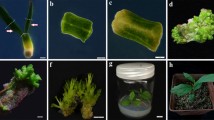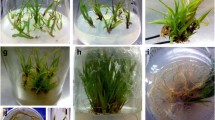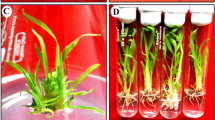Summary
An efficient and reproducible protocol for the regeneration of shoots at high frequency was developed by using explants derived from the axillary meristems from the cotyledonary nodes of in vitro-germinated seedlings of chickpea (Cicer arietinum L.). Culture conditions for various stages of adventitious shoot regeneration including the induction, elongation, and rooting of the elongated shoots were optimized. The medium for synchronous induction of multiple shoot buds consisted of Murashige and Skoog basal medium (MS) with low concentrations of thidiazuron (TDZ), 2-isopentenyladenine (2-iP), and kinetin. Exclusion of TDZ and lowering the concentration of 2-iP and kinetin in the elongation medium resulted in faster and enhanced frequency of elongated shoots. Cultivation of the stunted shoots on MS with giberellic acid (GA3) increased the number of elongated shoots from the responding explants. pH of the medium played a very crucial role in the regeneration of multiple shoot buds from the explants derived from cotyledonary nodes. A novel rooting system was developed by placing the elongated shoot on a filter paper bridge immersed in liquid rooting medium that resulted in rooting frequency of up to 90%. A comprehensive protocol for successful transplantation of the in vitro-produced plants is reported. This method will be very useful for the genetic manipulation of chickpea for its agronomic improvement.
Similar content being viewed by others
References
Barna, K. S.; Wakhlu, A. K. Somatic embryogenesis and plant regeneration from callus cultures of chickpea (Cicer arietinum L.). Plant Cell Rep. 12:521–524; 1993.
Barna, K. S.; Wakhlu, A. K. Whole plant regeneration from Cicer arietinum from cellus cultures via organogenesis. Plant Cell Rep. 13:510–513; 1994.
Behrend, J.; Mateles, R. I. Nitrogen metabolism in plant cell suspension cultures. I. Effect of amino acids on growth. Plant Physiol. 56:584–589; 1975.
Briggs, B. A.; McCulloch, S. M.; Edick, L. A. Micropropagation of azaleas using thidiazuron. Acta Hortic. 226:205–208; 1988.
Chevre, A. M.; Gill, S. S.; Mouras, A.; Salesses, G. In vitro multiplication of chestnut. J. Hort. Sci. 58:23–29; 1983.
Dineshkumar, V.; Kirti, P. B.; Sachan, J. K. S.; Chopra, V. L. Plant regeneration via somatic embryogenesis in chickpea (Cicer arietinum L.). Plant Cell Rep. 13:468–472; 1994.
Fontana, G. S.; Santini, L.; Caretto, S.; Frugis, G.; Mariotti, D. Genetic transformation in the grain legume Cicer arietinum L. (chickpea). Plant Cell Rep. 12:194–198; 1993.
Henny, R. J.; Fooshee, W. C. Thidiazuron stimulates basal bud and shoot formation in Alocasia × Chantrieri Andre. Hort. Sci. 25:124; 1990.
Hyndman, S. E.; Hasegawa, P. M.; Bressan, R. A. The role of sucrose and nitrogen in adventitious root formation on cultured rose shoots. Plant Cell Tiss. Organ Cult. 1:229–238; 1982.
Jodha, N. S.; Subbarao, K. V. Chickpea: world importance and distribution. In: Saxena, M. C.; Singh, K. B., eds. The chickpea. Wallingford, UK: CAB International; 1987:1–10.
Kar, S.; Basu, D.; Ramakrishnan, N. A.; Mukherjee, P.; Johnson, T. M.; Nayak, P.; Sen, S. K. Expression of Cry IA(c) gene of Bacillus thuringiensis in transgenic chickpea plants inhibits development of pod borer (Heliothis armigera) larvae. Transgenic Res. 61:177–185; 1997.
Kar, S.; Johnson, T. M.; Nayak, P.; Sen, S. K. Efficient transgenic plant regeneration through Agrobacterium-mediated transformation of chickpea (Cicer arietinum L.). Plant Cell Rep. 16:32–37; 1996.
Khan, S. K.; Ghosh, P. D. Plantlet regeneration from cotyledonary nodes of chickpea. Int. Chickpea Newsl. 11:22–24; 1984.
Krishmamurthy, K. V.; Suhasini, K.; Sagare, A. P.; Meixner, M.; deKathen, A.; Pickardt, T.; Sheider, O. Agrobacterium-mediated transformation of chickpea (Cicer arietinum L.) embryo axes. Plant Cell Rep. 19:235–240; 2000.
Malik, K. A.; Saxena, P. K. Thidiazuron induces high frequency shoot regeneration in intact seedlings of pea (Pisum sativum), chickpea (Cicer arietinum), and lentil (Lens culinaris). Aust. J. Plant Physiol. 19:731–740; 1992.
Murashige, T.; Skoog, F. A revised medium for rapid growth and bioassays with tobacco tissue cultures. Physiol. Plant. 15:473–497; 1962.
Polisetty, R.; Patil, P.; Deveshwar, J. J.; Khetrapal, S.; Chandra, R. Rooting and establishment of in vitro grown shoot tip explants of chickpea (Cicer arietinum L.). Ind. J. Exp. Biol. 34:806–809; 1996.
Prakash, S.; Chaudhury, J. B.; Jain, R. K.; Choudhury, V. K. Factors affecting plant regeneration in chickpea. Cicer arietinum L. Ind. J. Exp. Biol. 30:1149–1153; 1992.
Prakash, S.; Chowdhury, J. B.; Yadav, N. R.; Jain, R. K.; Chowdhury, V. K. Somatic embryogenesis in suspension cultures of chickpea. Ann. Biol. 10:7–14; 1994.
Preece, J. E.; Imel, M. R. Plant regeneration from leaf explants of rhododendron ‘P.J.M. hybrids’. Sci. Hortic. 48:159–170; 1991.
Rao, B. G. Regeneration from induced embryoids of gram (Cicer arietinum L.). Adv. Plant Sci. 3:299–302; 1990.
Rao, B. G. Influence of explant and its stages of development on response for somatic embryogenesis in chickpea. Adv. Plant Sci. 4:43–47; 1991.
Rao, B. G.; Chopra, V. L. Genotypic and explant differences in callus initiation and maintenance in chickpea. Int. Chickpea Newsl. 17:10–12; 1987.
Rao, B. G.; Chopra, V. L. Regeneration in chickpea (Cicer arietinum L.) through somatic embryogenesis. J. Plant Physiol. 134:637–638; 1989.
Raven, J. A. Biochemical disposal of excess H+ in growing plants? New Phytol. 104:175–206; 1986.
Riazuddin, S.; Hussain, T.; Malik, T.; Farooqi, H.; Abbar, S. T. Establishment of callus-tissue culture and the induction of organogenesis in chickpea. Pak. J. Agri. Res. 3:339–345; 1988.
Sagare, A. P.; Suhasini, K.; Krishnamurthy, K. V. Plant regeneration via somatic embryogenesis in chickpea (Cicer arietinum L.). Plant Cell Rep. 12:652–655; 1993.
Sharma, K. K.; Bhojwani, S. S.; Thorpe, T. A. Role of the cotyledonary tissue in the in vitro differentiation of shoots and roots from cotyledon explants of Brassica juncea (L.) Czern. Plant Cell Tiss. Organ Cult. 24:55–59; 1991.
Sharma, K. K.; Ortiz, R. Program for the application of genetic transformation for crop improvement in the semi-arid tropics. In Vitro Cell. Dev. Biol. Plant 36:83–92; 2000.
Sharma, L.; Amla, D. V. Direct shoot regeneration in chickpea (Cicer arietinum L.). Ind. J. Exp. Biol. 36:605–609; 1998.
Shri, P. V.; Davis, T. M. Zeatin induced shoot regeneration from immature chickpea (Cicer arietinum L.) cotyledons. Plant Cell Tiss. Organ Cult. 28:45–51; 1992.
Sonia; Rizvi, S. M. H.; Singh, R. P.; Sharma, K. K.; Jaiwal, P. K. In vitro regeneration and genetic transformation of chickpea (Cicer arietinum L.). In: Jaiwal, P. K.; Singh, R. P., eds. Biotechnology for the Improvement of Legumes. Dordrecht: Kluwer Academic Publishers; 2002 (in press).
Subhadra; Vashishth, R. K.; Chowdhury, J. B.; Singh, M.; Sareen, P. K. Multiple shoots from cotyledonary node explants of non-nodulating genotype (ICC435M) of chickpea, Cicer arietinum L. Ind. J. Exp. Biol. 36:1276–1279; 1998.
Suhasini, K.; Sagare, A. P.; Krishnamurthy, K. V. Direct somatic embryogenesis from mature embryo axis in chickpea (Cicer arietinum L.). Plant Sci. 102:189–194; 1994.
Author information
Authors and Affiliations
Corresponding author
Rights and permissions
About this article
Cite this article
Jayanand, B., Sudarsanam, G. & Sharma, K.K. An efficient protocol for the regeneration of whole plants of chickpea (Cicer arietinum L.) by using axillary meristem explants derived from in vitro-germinated seedlings. In Vitro Cell.Dev.Biol.-Plant 39, 171–179 (2003). https://doi.org/10.1079/IVP2002387
Received:
Accepted:
Issue Date:
DOI: https://doi.org/10.1079/IVP2002387




